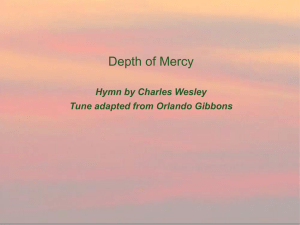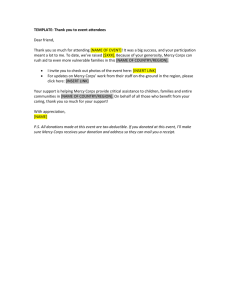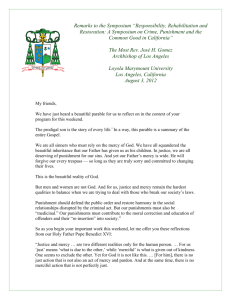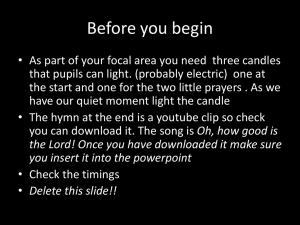Faith Play Day
advertisement
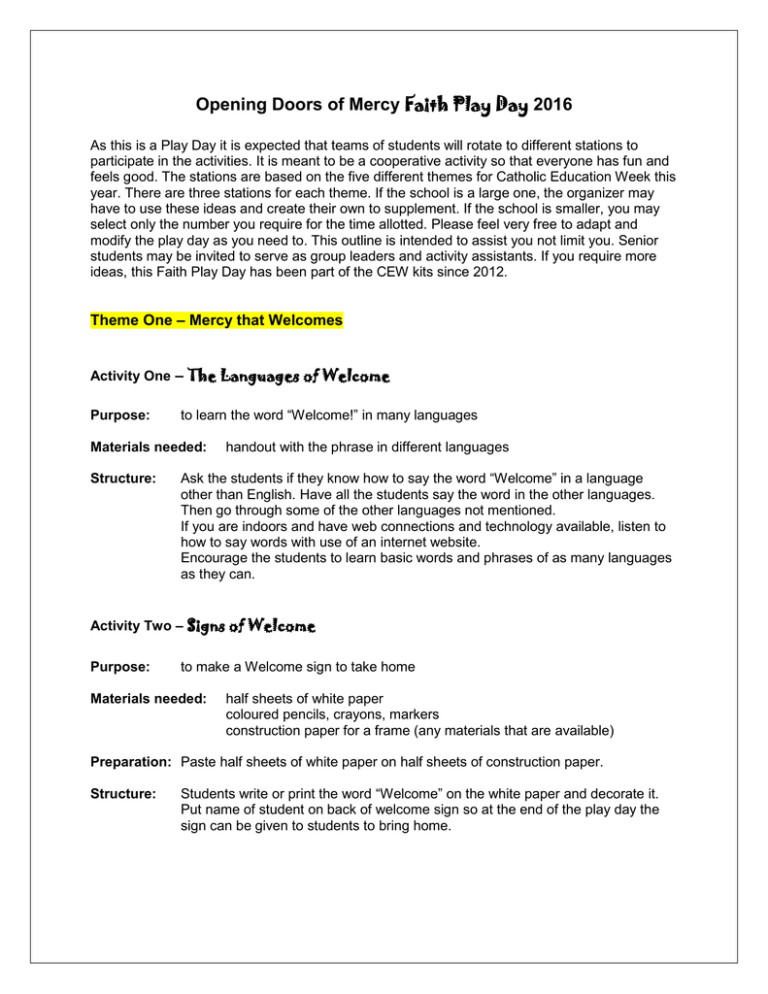
Opening Doors of Mercy Faith Play Day 2016 As this is a Play Day it is expected that teams of students will rotate to different stations to participate in the activities. It is meant to be a cooperative activity so that everyone has fun and feels good. The stations are based on the five different themes for Catholic Education Week this year. There are three stations for each theme. If the school is a large one, the organizer may have to use these ideas and create their own to supplement. If the school is smaller, you may select only the number you require for the time allotted. Please feel very free to adapt and modify the play day as you need to. This outline is intended to assist you not limit you. Senior students may be invited to serve as group leaders and activity assistants. If you require more ideas, this Faith Play Day has been part of the CEW kits since 2012. Theme One – Mercy that Welcomes Activity One – The Languages of Welcome Purpose: to learn the word “Welcome!” in many languages Materials needed: Structure: handout with the phrase in different languages Ask the students if they know how to say the word “Welcome” in a language other than English. Have all the students say the word in the other languages. Then go through some of the other languages not mentioned. If you are indoors and have web connections and technology available, listen to how to say words with use of an internet website. Encourage the students to learn basic words and phrases of as many languages as they can. Activity Two – Signs of Welcome Purpose: to make a Welcome sign to take home Materials needed: half sheets of white paper coloured pencils, crayons, markers construction paper for a frame (any materials that are available) Preparation: Paste half sheets of white paper on half sheets of construction paper. Structure: Students write or print the word “Welcome” on the white paper and decorate it. Put name of student on back of welcome sign so at the end of the play day the sign can be given to students to bring home. Activity Three – Welcome Song Purpose: to learn a welcome song with gestures Materials needed: web connection, computer, projector https://www.youtube.com/watch?v=ahfBAPENSZQ – 1.55 min OR someone to learn the song and gestures who will teach the other children Alternative songs: https://www.youtube.com/watch?v=Kf2AvpruhU0 – 4.23 min Preparation: Put the children in a formation where everyone can see the screen or the leader. Video/leader shows the children the Welcome Song (words and gestures all together). Learn both together or learn song first and then gestures. Words to the Welcome Song: I’m so excited on the top of the mountain. I feel the joy down in my heart. That is why I am singing and dancing. You are welcome, we love you our friend. Welcome friend. Alternate first line My name is Sarah and I’m so excited… Structure: Groups learn the song and gestures, then sing and dance facing one another. If time is longer, invite the students to create their own gestures to the song. Theme Two – Mercy that Loves Activity Four – A Love Letter Purpose: to share love with someone who loves us Materials needed: lined paper or cards envelopes pencils (lead and coloured) stickers Preparation: Sharpen all the pencils. You may want older students to assist younger students so the young ones can participate fully. Structure: Ask the students to list all the things that their loved one does for them. Ask the students to write a love letter to that loved one to say thank you for the countless ways that they help and take care of them. Mercy is about gratitude. Make sure the one composing the card signs the card, so the young student signs the card not the helper. Activity Five – God’s Love Grows and Grows Purpose: to learn that God’s love is infinite and it will always find you and be there for you Materials needed: any material (paper, cloth, felt, clay, etc.) available scissors glue Preparation: For younger children – cut hearts in different sizes and colours of construction paper (this is so paper is not wasted). You may have access to die-cut machines where you can have multiple copies cut at one time. For older children – photocopy attached pattern on red or pink or white paper that once cut, will create interlinked hearts (see handout with above title). Structure: Set up two distinct stations – one for young children and one for older children. It is important to begin session by using the script below. Try not to waste paper or any of the supplies. Have the students create a symbol of God’s love growing as we grow. Script: “God’s love is not [limited], it is infinite. God’s love grows and grows. God’s love will always find you and be there for you. You can always count on God. A heart symbol is often used to express love. This heart reminds us how God’s love continually grows, reaching out to us.” Handout and idea found in Hands-on FAITH by Mary Doerfler Dall page 17-18 Activity Six – A Love Story Purpose: to hear a love story and to reflect on its message Materials needed: a good love story… Love You Forever by Robert Munsch The Kissing Hand by Audrey Penn You Are Special by Max Lucado You Are Mine by Max Lucado Preparation: Prepare by reading the book several times so you can read the story smoothly and with good expression. If it is possible to show the pages as you read, by using a projection device, that is helpful. Structure: Have the students sit criss-cross apple sauce. Before you read the story ask the students to pay attention to some detail so they will focus on the story’s message, for example: “After I read the story I am going to ask you what lesson can we learn from this story.” Have a discussion about the lesson that that story teaches. Listen to everyone’s idea. Sometimes a person has an interesting interpretation that comes from listening closely. Theme Three – Mercy that Forgives Activity Seven – The Forgiving Father Purpose: to learn the deeper meaning of the parable – mercy that forgives Materials needed: children’s lectionary version of the parable (one provided below) props (see list below, adapt as needed) Note to teacher: When dramatizing this parable, please contextualize it to assist students to make meaningful connections. For example, the Father represents God and both sons represent the different responses that we can have to God’s great love for us. Directions: Most students should recognize the story of the Prodigal Son. Invite senior students (Grades 7-8) to take roles listed below and give them their prop symbol. You may want to practice the skit before the day of the Play Day so the students have an idea of what to do and where to go. Narrator: should have a special book with the script inside (can be the teacher) Father: two bags with gold coins/monopoly money in a wallet Son that stays: child with glasses and reading a book – well behaved Son that leaves: child with attitude, duffle bag stuffed with belongings, long sleeves that hide tattoos (when he becomes poor, he takes off his long sleeves to reveal his tattoos) Farmer: Overalls, straw hat and a shovel Pigs: stuffed animals Servant 1: Leather coat – or a coat that kids would think is the best Servant 2: Big ring and sandals Servant 3: Platter with fake meat on it, maybe potatoes and carrots (check out JK play centre) The Children’s Lectionary version of the Prodigal Son (Luke 15:11-32) There was a man who had two sons. The younger son said to his father, “Give me my half of all the family property – all that would be mine after you die.” So the father divided everything he owned between his two sons. A few days later, the younger son packed up all his things and left home to live in a faraway country. But he wasted all of his money living a wild life. After he had spent everything, there was a bad famine in that country and he became very hungry but could not buy any food. He went to work for a farmer who sent him out to feed the pigs. The young man was so hungry that he could have eaten the food the pigs ate, but no one offered him even that. At last, he came to his senses and said to himself, “The people who work for my father have more than enough food to eat, and here I am starving to death. I will go back to my father and I will say to him, ‘Father, I have sinned against God and against you; I am no longer good enough to be called your son. Treat me like one of your workers.’” So the young man started home. But while he was still a long way off, his father saw him coming and ran out to meet him. He took his son in his arms and kissed him. The young man said, “Father, I have sinned against God and against you. I am no longer good enough to be called your son.” But his father said to the servants, “Quick! Bring out the best clothes and put them on him. Put a ring on his finger and shoes on his feet. Get our best calf and prepare a feast. Let’s eat and celebrate because my son was dead and he has come back to life. He was lost and has been found!” And they began to celebrate. Debrief: How did you feel when the son asked for half of the family property? How did you feel when the son wasted all the money? How did you feel when the Father welcomed his son home? What does this story teach us? Activity Eight – Father, I Have Sinned Purpose: to learn a song about God’s forgiveness Materials: YouTube version of the song by Eugene O’Reilly, CSsR (https://www.youtube.com/watch?v=-v9TmEqaiQg) other source of the same song or another song about the same message device to play music Preparation: Become familiar with the song. Look at words below. Be comfortable helping others to learn the song. Structure: Ask the students to listen to the song without singing the first time. Once students have listened to the song, ask them “Who is the Father?” Teach the refrain first, then the verses. Decide ahead of time, which verses you will teach, depending on the time you’ll have for each session. Make sure that at least the refrain is sung through and verse one. FATHER, I HAVE SINNED by Eugene O’Reilly 1. Father, I have sinned, help me find my way. Remember not my sins, just let me hear you say: Refrain: I forgive you; I love you, you are mine; take my hand. Go in peace; sin no more, beloved one. 2. Father, I have turned my back and walked away. Depended on my strength, and lived life my own way. Refrain. 3. Father, I have closed my heart to those in need. Thought only of myself, a victim of my greed. Refrain. 4. Father, I have loved, if love’s the word to use. I’ve played so many games; they’ve left me so confused. Refrain. 5. Father, I’ve returned. I’m home with you to stay, standing by your door, knowing that you’ll say: Refrain. Activity Nine – A Letter from a Special Friend Purpose: to receive a letter from Jesus, a letter of love and friendship Materials: provide a copy of the letter for each participant (young children may have to have the letter read to them by older children) Preparation: Decide how many letters you need photocopied (or hand written by older students for younger students). Letters do not need to be in envelopes but can be folded and sealed by stickers so the students open the letter themselves. Older students can experience the message by copying it out for the younger students; be sure the letters are signed by Jesus (not the copier). If possible, have the students’ names written on the outside of the letter so it is their letter. Structure: Gather the students in the space allotted for Activity Nine. Explain that a special letter has come to the school for each student (we do this for letters from Santa Claus). We want the students to take their time to read this special letter. Once they have read their letter they can decorate the letter. Students can take their letters home with them. Theme Four – Mercy that Lives the Gospel Activity Ten – Christian Meditation Purpose: to experience or learn the practice of meditation Materials: a space large enough where each child has a chair a chime or bell a timer a script for the person leading the meditation Preparation/Structure: Script for Leader: Have students seated in chairs, if chairs can be placed in a circle – good. If chairs are not possible, be sure that the students are not touching each other as they sit on the floor. This station can be held outdoors so long as the space is not really noisy. We are going to practice a prayer style called meditation. Unlike the many ways we pray with words, this prayer only uses one word. We will repeat inside ourselves the word Ma-ra-na-tha which means “Come, Lord Jesus.” We say the word in four parts Ma – ra – na – tha. As we say it to ourselves we breathe deeply. To meditate we need to get our body ready: + we sit with our feet flat against the floor + we sit with our back straight + we sit with our hands and arms in our lap + we sit with our eyes closed gently We begin to meditate when we hear the chime ring three times. I will signal the end of the meditation with the chime ringing three times. Are you ready to begin? Ring chime three times and wait until several students are struggling to keep their bodies still. Ring chime to signal end. Activity Eleven – Love of the Earth Purpose: to actively show our love for the earth by cleaning the school yard or the hallways Materials: small white bags or one large garbage can a particular part of the school yard gloves (brought from home) if required OR wash hands after picking up Preparation/Structure: Divide school yard into sections so the whole area will be cleaned by the end of the play day. Be sure to send home a message a couple of days before about the need for garden gloves for the clean-up. Dollar stores sell gloves for a dollar if some students do not come with gloves. Ask students NOT to pick up glass, or needles, or anything that could be dangerous. Older students can be responsible for marking dangerous items and a call to the city can have these object removed safely. It is helpful to remind students that it is not showing love to the earth by littering. We need to teach young people this lesson again and again. Activity Twelve – Cooperation is the Name of the Game Purpose: to ask students to work cooperatively to complete the task Materials: two wooden planks (2” x 4” x 6’) for each team outdoor area is best suited for this activity Preparation/Structure: Establish a start and finish line (pylons are useful). Have all the students in one group stand on one plank with the other plank behind them. Both planks should be behind the start line. When you say “GO,” the group picks up the plank that is behind them. They pass it along the line of their teammates and then put it on the ground so they can walk along it toward the finish line. Once all of them are on the second plank, they pick up the plank and repeat the process until they are over the finish line. Invite the teams to discuss how they can cooperatively complete the task more successfully as a team. If time allows, have the students do the task again to see if their ideas are better. Theme Five – Mercy that Rejoices Activity Thirteen – Works of Mercy Relay Race Purpose: to practice the works of mercy in a fun manner Materials: apples (fake or real) juice bottle/can chairs/large animal cage naked doll and dress get well card (homemade) bandage or crutches sheet blankets and chairs Preparation: Prepare one sign with each of the Works of Mercy on it: FEED the HUNGRY; DRINK to the THIRSTY; CLOTHE the NAKED; SHELTER the HOMELESS; TEND to the SICK; VISIT the IMPRISONED; and BURY the DEAD. Set up stations for each team; put up the signs for each work of mercy. So if two teams are competing – you need double Stations (7 stations x 2). At each station have a work of mercy sign displayed and a chair. Have a box with all the materials listed above and place the box away from the start line. The team who can demonstrate correctly the works of mercy with persons and items wins. Gymnasium is a good place to do this relay. Group decides what action will demonstrate the work of mercy for each station. One participant goes to the box to find what will demonstrate Feed the Hungry. Hopefully the participant will select the apple and take the apple to sit on the chair. The team asks the judge, “Is that right?” The judge says, “yes” and the team tries to get the next station completed. If the judge says “No”, then the person in the station must return to the box to get the appropriate item and try again. Once all the stations have been approved by the judge, the group is finished the race. Instructions to the teams: 1. As you can see there are seven stations for this relay race. 2. All members of the team must stay behind the starting line until the judge approves of the previous demonstration of the work of mercy. 3. The race begins when the judge says, “Ready, set, go.” 4. The first participant runs to the box and finds an item that will correctly demonstrate the work of mercy. Takes the item and goes to sit on the chair in the correct station. 5. The team asks, “Judge, is that right?” a) If the judge says “yes”, then the next participant tries to demonstrate the next station with an item from the box. b) If the judge says “no”, then the participant must return to the box to get the correct item, return to the chair. The team asks again, “Judge, is that right?” 6. Continue until all the stations have been demonstrated. 7. Some stations will require no participant, one participant or two participants to correctly demonstrate. Correct demonstrations of each Work of Mercy Station: Feed the Hungry – a participant sitting on chair with an apple in the station Station: Drink to the Thirsty – a participant sitting on chair with a juice bottle or can in the station Station: Clothe the Naked – Doll is dressed and place on a chair in the station Station: Shelter the Homeless – Make a fort with blankets and chairs (gym mats can work too) and put a participant in the fort in the station Station: Tend to the Sick – participant with Bandage or Crutches receiving Get Well card from another participant Station: Visit the Imprisoned – Participant is imprisoned in chairs/cage and visited by another participant Station: Bury the Dead – Participant is wrapped in a sheet – face covered Structure: Set up teams of eight. If team has fewer than eight – then have two judges – one for each team to check off that the station is correctly demonstrated. The works of mercy signs ought to give sufficient clues about what is required. But if a team is struggling, give them hints. Encourage the teams to complete the activity. Activity Fourteen – Pinwheels for Mercy Purpose: to create pinwheels for Mercy Materials: paper handout with pattern for Pinwheel coloured pencils bulletin board straight pins straws scissors glue Preparation/Structure: Photocopy enough patterns for each student to receive one. Cut pattern out for younger children so they only need to decorate – help them to assemble too. Older children ought to be able to cut their own, but it is a time saver if the cutting has been done ahead of time. Decorate the pinwheel inside and outside. Assemble the pinwheel by following the instructions on the handout. Put the pinwheels on the bulletin board so it is a reminder that we all need to spread mercy like the pinwheel. Activity Fifteen – Enjoy some REST and a TREAT Purpose: to enjoy some rest from all the activity of the Play Day Materials: a shady tree if outdoors a treat for each participant Joyful music (Happy by Pharrell Williams) OR show video clips of movie “Happy Feet” Structure: Invite the students to enjoy the treat (popsicle) and the rest from activity. This is like a Sabbath moment from God. God rested on the seventh day. God showed us it is important to take a break from activity and enjoy the presence of others.

